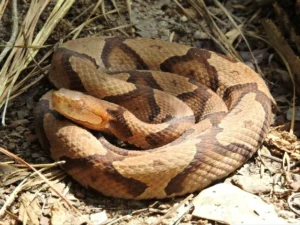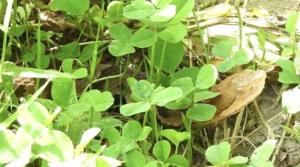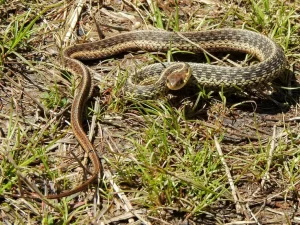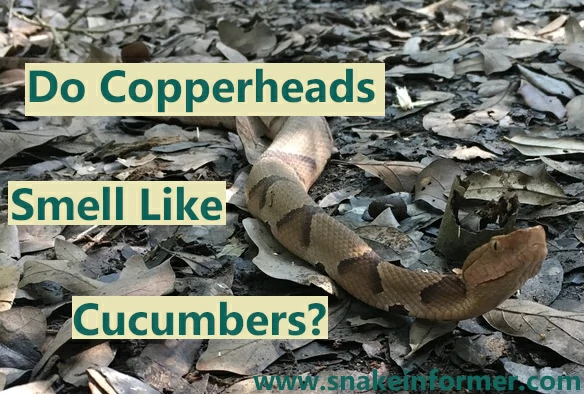Copperheads are heavy-bodied snakes found in the eastern and central portion United States. A common belief about these snakes is that they smell like cucumbers, but is there any truth to this?
Copperhead snakes do not really smell like cucumbers. While they can produce a musk as a defensive measure, that musk does not smell like cucumbers.
The idea that copperhead snakes emit a cucumber-like odor originates from anecdotal experiences, especially in rural areas where these snakes are more common.
Copperhead Snakes Emit a Defensive Odor
Copperhead snakes are eaten by a wide variety of predators, such as hawks, owls, small mammals, and even other snakes.
For this reason, these snakes developed several ways to defend themselves.

One way they defend themselves is by releasing a foul-smelling, greasy fluid, called ‘musk’, from glands located near the cloaca.
When a copperhead is grabbed by an attacker, it may release its musk to deter the predator.
In addition to musking, copperheads also often defecate when threatened.
Musk, mixed with fecal matter, can create a very pungent smell, that is extremely unpleasant to many predators.
Releasing this foul-smelling secretion makes copperhead snakes a less appealing meal, increasing their chance of survival.
Also, some predators will learn to associate the smell of copperhead musk with an unpleasant taste, and may avoid attacking other copperhead snakes in the future.
Does the Musk of Copperhead Snakes Smell Like Cucumbers?
Some people describe Copperhead musk as having a “cucumber-like” odor. However, the scent can be described in various ways.
Researchers often describe Copperhead musk as smelling earthy, pungent, or like decaying vegetation – but rarely cucumber-like.
The “cucumber smell” is anecdotal, and not reported in scientific literature.
It’s one of those smells that smells different to different people.
To one person, it may smell earthy, and another person may interpret the odor as something else.
People perceive smells differently, so it’s possible that the smell of copperhead musk can be perceived as smelling like cucumbers by some people. However, it’s important to remember that the purpose of musk is to repulse predators, so it smells anything but pleasant or refreshing.
Why Some People Think Copperheads Smell Like Cucumbers
There is a practical explanation for why some people may think the musk of copperhead snakes smells like cucumbers.
1. Coincidence
The outdoors are full of many natural aromas – such as soil, and crushed or decaying vegetation.
People hiking outdoors might detect a strange odor coming from nearby vegetation, that reminds them of cucumbers.
Moments later, they see a copperhead, and mistakenly associate the scent, with the snake they discovered.

2.”Easy to remember” warning sign
The idea that something “smells like cucumbers” is very easy to remember. It can easily be told to children, and other people.
It would be much harder to remember a smell, without associating it with something familiar.
You Likely Wouldn’t Smell a Hidden Copperhead
Copped snakes only release their musk as a defense when they are grabbed, cornered, or under stress.
For this reason, you would not smell the musk of a hidden copperhead nearby, unless you disturb the snake (such as stepping on it), or try to handle it.
Smell is not a reliable warning signal for the presence of copperhead snakes.
If you’re in an area where copperheads are common, keep your eyes on the ground, and take proper outdoor precautions (such as wearing boots).
Do not rely on your nose, because smell is not a reliable warning signal for the presence of copperhead snakes.
Many Snakes Use Musking as a Defense Mechanism
Copperhead snakes are not the only snakes that musk.
Other snake species, such as Garter snakes, Rat Snakes, Milk snakes, Kingsnakes, and Corn snakes also musk to defend themselves from predators.

Apart from musking, these snakes also employ several other defensive tactics.
Snakes Do Not Like to Interact With Humans
Generally, snakes do not like to interact with humans, or any other creature larger than them.
When you approach a copperhead snake, it will react in the same way it would react to a snake or any other predator in the wild.
It may coil, and release its musk, to make itself less appealing.
What Other Animals Use Odors to Defend Themselves?
Using a foul odor as a defense against predators is not uncommon in the animal kingdom.
Here are a few other animals that produce a foul smell to deter predators.
1. Skunks
Skunks are the most well-known animals that use bad odors as a defense against predators.
When a skunk is approached by a predator, it can shoot out a foul-smelling spray from anal glands, located inside the rectum, and the base of the tail.
This spray is emitted as a stream, aimed at the predator’s face, and is accurate as far as 10 feet (3 meters)!
If the skunk is being chased, by a predator, it can shoot out its spray in a cloud, that the predator has to run through.
A skunk spray can cause serious irritation and even temporary blindness. It is powerful enough to ward off even large predators such as bears.
Despite their unique defense, skunks are still preyed on by the great horned owl (Bubo virginianus), which is their only regular predator.
2. Opossums
Opossums are fairly slow-moving creatures and are preyed on by foxes, snakes, and many predatory birds.
However, these animals are not completely defenseless.
When approached by a predator on land, these animals may play dead, with their tongues hanging out. A foul-smelling fluid is also secreted from the anal glands, which mimics the smell of a dead animal.
Taking on the appearance and smell of a dead animal increases Opossums’ chances of survival. Many predators are discouraged from eating them – and instead, look for a fresher meal elsewhere.
3. Stinkbugs
‘Stinkbug’ can refer to any of about 5,000 insect species in the family Pentatomidae.
These insects get their name from the foul-smelling secretions they produce to deter predators.
When threatened or crushed, stinkbugs release a pungent spray, generally composed of aldehydes and alkanes.
The smell of the spray can transfer to the resting place of the insect, such as leaves, or fruits, giving them a nauseating taste.
Interestingly, stinkbugs are not the only insects with chemical defenses. For example, beetles in the genus Eleodes, exude a foul-smelling odor and and a very distasteful liquid to ward off predators.
4. Sea Hares
Using foul-smelling odors as a defense against predators is not only limited to terrestrial animals.
Sea hares are marine snails found in shallow water.
When threatened, these mollusks can release a white, purple, or red ink, which dyes the surrounding water and affects its predator’s olfactory senses ( the sense of smell).
This secretion is very unpleasant to many predators and makes sea hares a less appealing meal.
Conclusion
The idea that copperheads smell like cucumbers is anecdotal, but it’s not a reliable way of knowing when one of these snakes is nearby.
While it’s true that copperheads emit a defensive odor when threatened, the smell is highly subjective.
What smells like cucumber to one person, might smell like rotting vegetation to another.
When hiking outdoors, the best way to avoid copperhead encounters is by exercising caution, and relying on visual awareness – rather than smells.
Hi, my name is Ezra Mushala, i have been interested animals all my life. I am the main author and editor here at snakeinformer.com.

